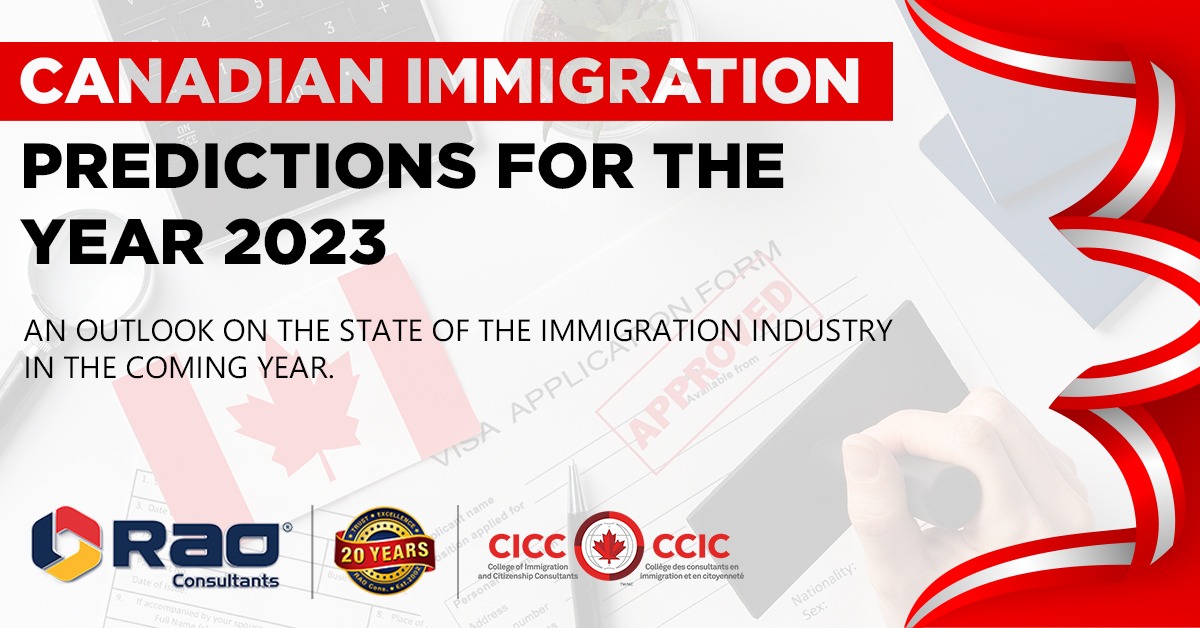Canadian Immigration Predictions for the Year 2023

An outlook on the state of the immigration industry in the coming year.
A record set a century ago has been broken: immigrants now account for 23% of Canada’s total population, according to the most recent census.
The Canadian government appears unwavering in its dedication to immigration and the acceptance of newcomers as we head into 2023. Increased immigration is expected to contribute to Canada’s social and economic growth, and the country will use its humanitarian aid capacity to help reunite families and support vulnerable populations.
This article provides a high-level forecast of possible immigration trends in Canada for the coming year (2023).
Relating to the Customer: With any luck, the IRCC application backlog will continue to decrease.
The IRCC’s total application backlog has been steadily decreasing since September 2022. The IRCC backlog has been reduced by 400,000, according to information provided to CIC News.
To “reduce application inventories,” IRCC has received an additional $85 million and will add 2,521 “front-line operations staff” between March 2019 and November 2022. IRCC’s service standards and application backlog should continue to improve in 2023 if these trends hold.
The 2023 Immigration Levels Goal Set by Policymakers
According to the Immigration Levels Plan, Canada has set a record-high immigration target for 2023, suggesting that IRCC is confident it can handle the backlog while still welcoming a large number of newcomers.
Below is a breakdown of the 2023 Immigration Levels Plan goal (465,000) by immigration category.
- Parents and grandparents:28,500
- spouses/partners and children: 78,000
- Express Entry: 82,880
- Provincial Nominee Programs (PNP): 105,500
In this article, we will take a look at four of the most important routes to entering Canada.
Provincial Nominee Program in the Year 2023
To our surprise, we learned at the year’s end that the PNP will soon replace Express Entry as Canada’s preferred immigration program. PNPs are essential in assisting Canada in meeting emerging demands in the labor market. As a result, in 2023, Canada is projected to accept roughly 23,000 more immigrants through the PNP than through the Express Entry program.
Express Entry Program in the Year 2023
The anticipated implementation of ‘targeted’ Express Entry draws by IRCC in 2023 will further demonstrate Canada’s commitment to filling critical gaps in the local labor market. Instead of awarding ITAs to applicants based on their Comprehensive Ranking System (CRS) score, these draws will prioritize those with relevant work experience, language proficiency, and/or academic credentials.
Targeted Express Entry draws information can be found on this page.
Parents and Grandparents in the Year 2023
Even in 2023, Canada won’t back down from its support for family reunions. The success of Canada’s Parents and Grandparents Program is indicative of this trend (PGP). According to Canada’s most recent Immigration Levels Plan, over 28,000 newcomers will be welcomed next year through the PGP and other immigration pathways like the Super Visa.
Please take note that as of this writing, IRCC has not released any official information regarding the specific selection process it will use for the PGP in 2023.
International Students in the year 2023
A change to IRCC’s off-campus work hours policy for international students in Canada was announced in October.
International students with off-campus work authorization on their study permit in Canada will be able to work over 20 hours per week off-campus while classes are in session beginning on November 15, 2022 and ending at the end of 2023.
Over half a million international students may be able to work more hours while attending school in Canada between now and the end of next year thanks to this change, which is intended to help Canada better deal with labor shortages because Canada is experiencing “historic labor shortages and an unemployment rate which is low by historical standards.”
If we fast forward to 2023 in Canada, how will these changes affect the country?
Canada’s population and workforce stand to gain greatly from immigration, a trend that is expected to persist through at least 2023.
For instance, Canada should be able to ease more of the pressure currently hindering the country’s labor market due to the anticipated increase of newcomers to Canada through both PNPs and targeted Express Entry draws. Canada’s economy will benefit from the natural cycle of spending that occurs when people are employed, and this is especially true as more capable skilled immigrants enter the country, particularly those working in high-demand occupations.
More international students may eventually come to Canada now that the off-campus work hours rule has been temporarily lifted. This is because Canada is expected to become an even more attractive international student destination as a result of this change. In the event that this causes more international students to remain in Canada after they graduate, the new work hours policy will have a positive effect on the Canadian economy and job market (much like the Express Entry and PNP immigrants described above).
Consequently, immigration in 2023 should give all Canadians more reason to feel optimistic about the country’s future labor force and economic prospects.
To see how immigration truly affects Canada over the next year, all Canadians should keep an eye on the state of the economy and the job market.






